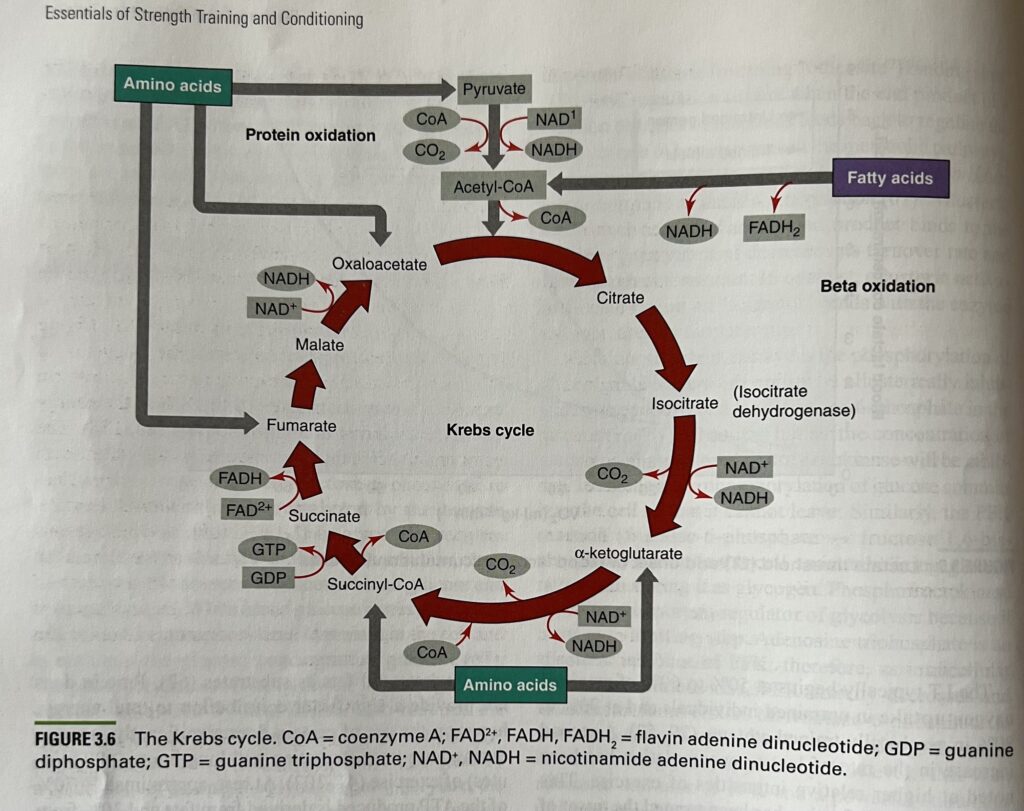Before I explain the three basic energy systems it’s important to know how ATP (Adenosine Triphosphate) plays a role in the body.
Energy derived from catabolic or exergonic reactions is used to drive anabolic or endergonic reactions through an intermediate molecule (ATP). ATP allows the transfer of energy from exergonic to endergonic reactions. Without ATP muscle activity would not be possible.
Three basic energy systems exist in mammalian muscle cells to replenish ATP:
Phosphagen system, Glycolysis, and Oxidative system.
When it comes to exercise related bioenergetics the terms anaerobic and aerobic metabolism are often used. Anaerobic processes do not require the presence of oxygen (short bursts of power) whereas aerobic depends on oxygen (long duration cardio). The phosphagen and glycolytic systems are anaerobic mechanisms that occur in the sarcoplasm of muscle cell. The Krebs cycle, electron transport, and the rest of the oxidative system are aerobic mechanisms that occur in the mitochondria of muscle cells and require oxygen as the terminal electron acceptor.
Of the three main macronutrients (carbs, protein, and fats) only carbs can be used for energy without the direct involvement of oxygen. Carbs are critical to anaerobic metabolism and thus critical to anaerobic performance such as sprinting and weight lifting (short bursts of power). All three energy systems are active during any given time in the body. However the size of the contribution to one is determined by the intensity and duration of exercise.
Without going into a deep dive on how these systems work on the cellular level I will try to explain in the simplest terms what each system does and when it is used.
Phosphagen system: This system provides ATP primary for short term high intensity activities such as resistance training and sprinting. This system is highly active at the start of any exercise regardless of intensity or duration. The cellular reaction that happens with this system provides energy at a higher rate but also in a small amount. Thus the phosphagen system cannot be used to sustain a long term state of energy.
Glycolysis: Also occurs in the sarcoplasm. It uses the breakdown of carbs from glycogen stored in the muscle and glucose in the blood to resyntheses ATP. The ATP resynthesis rate during glycolysis is not as rapid as the Phosphagen system however the capacity to produce ATP is much higher due to a larger supply of glycogen and glucose compared to creatine phosphate.
Oxidative system: The primary source of ATP at rest and during low-intensity activities. Uses primarily carbs and fats as energy. Protein does not provide a significant contribution to total energy. However the use of protein as energy does significantly increase when long term starvation and long bouts of exercise (over 90 minutes) kick in. At rest the body uses 70% fat and 30% carbs for energy. As intensity increases in the aerobic direction almost 100% of energy comes from carbs only. The oxidative metabolism of blood glucose and muscle glycogen begins with glycolysis. If oxygen is present in sufficient quantities (the aerobic state of cardio), the end product of glycolysis, pyruvate, is not converted to lactate but is transported to the mitochondria, where it is converted to a two-carbon molecule which enters the Krebs cycle. The Krebs cycle is a series of reactions that continues the oxidation of the substrate from glycolysis and produces two ATP indirectly from guanine triphosphate (GTP), via substrate level phosphorylation for each molecule of glucose. This is the steady aerobic state or “cardio” using oxygen seen in events like a long distance run.

REFERENCES
Haff, Gregory. Triplett, Travis. Essentials of Strength Training and Conditioning. Pg 44-52. Human Kinetics, 2016.
